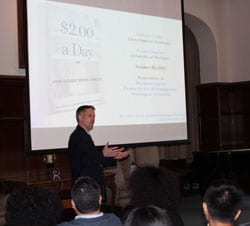A woman in Tennessee sells her plasma twice a week to help her family of four survive. She has little cash, about $2 a day, but she has a lot of company. The number of families living on $2 per person, per day, has soared to 1.5 million American households, including about 3 million children.
“What do they do to survive?” That’s what H. Luke Shaefer said he and Kathryn J. Edin decided to find out. They traveled to Chicago, Cleveland, Johnson City, Tenn., and the Mississippi Delta, and they never had to dig hard to find families who fit the $2-a-day description. The result is the book “$2 a Day: Living on Almost Nothing in America.”
“Is it fine if we [the government] just provide SNAP [Supplemental Nutrition Assistance Program] and maybe Medicaid? Does cash matter?” Shaefer asked Oct. 20 in his lecture at the Brown School of Social Work. “Does it matter if you have a little bit of cash in America?”
The “best evidence” that cash matters is what families go through to get it, Shaefer said, including selling plasma. It takes the woman in Tennessee about two hours, door to door. “She makes $30 the first time” and less the second time “because your body doesn’t generate as much. She says afterwards she gets really tired, especially if her iron is low.”
While selling plasma takes a physical toll, “it does have the benefit of being legal,” Shaefer said. Many other strategies that families rely on are illegal, he said.
“One thing that we saw pretty much across the board is the selling of Food Stamps, or SNAP,” he said. Often a merchant is involved. Someone might go to a bodega and ring through $100 of “fake” groceries and charge it it to his SNAP card. “The bodega owner gets $40 back in cash,” Shaefer said. “So I’m trading 40 percent of my purchasing power in SNAP to get the flexibility of $60 in cash. It turns out that this is a very serious felony.”
In fact, a person could face a $250,000 fine and up to 20 years in prison, he said. “So you could actually rob a bank and get less jail time than you could if you sell $50 of your food stamps.”
Shaefer, an associate professor of social work and of public policy at the University of Michigan, and Edin, the Bloomberg Distinguished Professor in the Department of Sociology at Johns Hopkins University, got to know 18 families. They learned that many heads of households with little cash do work, want to work and take pride in their work, but a low-wage labor market increasingly does not pay a living wage. The authors write that “the transformation of the social safety net is incomplete, with dire consequences.”
‘Welfare is dead’
Welfare is a shell of its former self, Shaefer said in his lecture. In 1994, Aid to Families with Dependent Children served 14.2 million Americans, including 9.6 million children. In all, it served about 5.5 percent of Americans. Today, post welfare reform, Temporary Assistance to Needy Families (TANF) serves 4.1 million people, including 2.9 million children. In all, it serves about 1.3 percent of Americans, he said.
“Welfare is dead,” Shaefer said, at least in the imaginations of poor families. “It’s not seen as an option.” For example, a woman in Chicago lost her job, has a daughter to support, and had no food at home. When the authors asked if she considered applying for TANF, she replied, “They just aren’t giving that out anymore.” A woman in Tennessee applied and said she was told “Honey, I’m sorry. There are just so many needy people we just don’t have enough to go around.”
The “ultimate litmus test” of any reform should be whether it serves to integrate the poor—particularly the $2-a-day poor—into society, rather than isolate them, Shaefer said. “The history of U.S. social welfare policy has really been one of isolation, except perhaps the Earned Income Tax Credit,” he said.
“How can we have policies that serve to integrate the poor, rather than isolate them?” he asked.
The United States needs “a functioning cash safety net” for the poor, Shaefer said. “What we have in TANF is not working in virtually all of the country” and must be reformed.
But above all else, maybe do what the families said they want, he said. “What did they want? They wanted decent work. They wanted the chance to make a contribution in a way,” Shaefer said.
“Maybe the defining social policy issue at the start of the 21st century is figuring out how we can expand economic opportunity for those at the bottom. Can we make the next generation a jobs generation? … It’s certainly clear that there’s enough work to do.”
Shaefer’s lecture, sponsored by the Center for Social Development, was part of the Brown School’s 2015-2016 Distinguished Lecture Series. View the entire lecture here.
